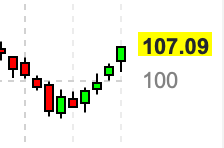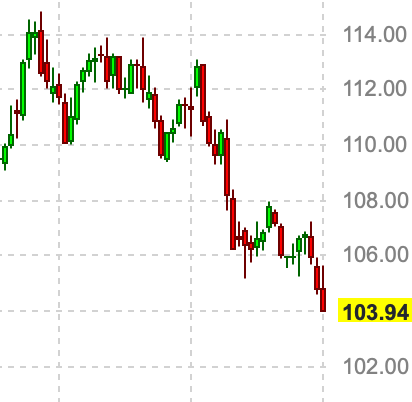Folks-
Arguably, the highlight of this week was the Powell presser on Wednesday and the jobs report on Friday. I already shared my view on the Powell’s performance the other day so I will not delve deeper into that one.
On surface, this week’s jobs report came in way hotter than expected - 263,000 jobs were added, compared to an estimate of about 200000. Average hourly wage increase came in well above the estimates at 0.6%. Previous number was 0.5%. These numbers are month over month, so when you add them up, they sit at odds with the FED’s goal of 2% annual inflation.
These numbers, while very good for the American workers, are unsustainable when viewed at from a historic averages.
So as expected, when this strong jobs report hit the wires, the market sold off on Friday from a high of about 4100 to almost 4000 within a matter of minutes. However, as the US session opened an hour later, most of these losses were erased and in fact we closed near the Thursday close at 4080.
This stunning reversal perhaps may be explained by what was in this labor report.
When I dig through this labor report, the strong numbers do not tell the whole story -
A) Most of the gains last month in the jobs came from the services sector and healthcare sector. This was followed by gains that came from the government hiring.
B) Most job losses came from the retail sector and transportation.
Unemployment rate remained steady at 3.7% but this is soon going to change. More on this later.
In the US and elsewhere, the labor markets are experiencing historic imbalances:
There are few sectors within the economy which were decimated by the authorities to fight the coronavirus pandemic- hotels, restaurants, airlines. They are no where near pre 2020 levels even today and are seeing some resurgence now.
The labor market itself shrank - the governments provided so much fiscal stimulus that several people retired early or stopped working altogether as the stimulus money was more than what they made working a regular job.
Then you have the question of how the BLS, the agency that publishes the jobs reports , measures these numbers - when we say 263000 new jobs were added, it does not mean 263000 people got new jobs. So, if one person does 3 jobs, that is counted as 3 new jobs.
This is important because behind this façade of strong NFP, you have many folks doing multiple jobs just to get by in high inflationary times.
There is also the question of losses in transportation and retail sector - I consider transport and retail to be the most leading sectors in economy and a loss of jobs in these sectors does not bode well for the economy.
So, when you add all this up- this strong NFP jobs report is actually a weak jobs report and may partially help explain the rally on Friday, in addition to a larger than normal positioning to the downside.
I expect the jobs report to deteriorate in coming months. Services sector is still recovering from the pandemic era losses and may show may be another couple of job gains in next few months as it tries to catch up to the pre 2020 era. Business travel is no where near pre 2020 levels - all of this may take time to catch up, if it catches up at all. However, I think come Spring 2023, the situation with unemployment will look much different and I think we will be in 5% plus range.
The FED response to this will be predictable and also shows how they are behind the curve- ideally they need to focus on the job losses in the retail and warehousing. However, predictably they will focus on the job gains in the hotels and restaurants which are going to be the last shoes to drop anyways.
You can read the BLS summary of November jobs report here.
Fun poll
Are you guys bullish or bearish next week and we will see how it aligns with my own views in later sections :)
Let us review some levels and thoughts for the S&P500 Emini this week now
I want to start from describing where we are in the auction structure , zoom out a little bit higher than the weekly and daily time frames.
Regular readers know that I did not see much selling below 3425-3500 area when we carved out that low in late September and early October. The majority view at that time was that we will continue to sell off towards 3000 but I did not believe so. I thought we were oversold and given the seasonality, the mid term election trends and extreme pessimism, we will rally towards 40000. We have rallied more than 15% since- Friday close has us an inch from 4100.
Zooming into the lower time frames, my last weekly plan called for any dips into 3900 area to be shallow and I expected these may get bought for a trip towards 4100-4150. This was indeed the case as we briefly dipped into 3930s this week only to be bought and rally sharply afterwards into 4100s.
What were some of the other calls that worked out well?
Bonds
I called for a low in the bonds and a top in the yields when TLT was trading near 92-93 bucks. What has TLT done since?
TLT has made a beeline to the upside having rallied in tandem with the stocks, now up about 15 handles.
My other call was the top in Dollar index at 113-114
What has the dollar done since? A series of lower lows and lower highs.
On the energy front
Most recently I called for a range on the WTI between 75 and 82 . This range has been a magnet for Crude oil’s price action last 10 days or so and we have been seeing nice ranging action in the oil.
I think oil market is in crosshairs of a perilous combination of supply shocks, economy risk and politics. If you look at the oil market from a prism of weakening economy over next year or so, then it makes sense for the oil market to be trading much lower. Lower than USD 50 to the barrel.
However, when you shift your focus away to the politics around oil - I could see a volatile year ahead for oil. A much lower oil market means the gasoline prices also crash - thereby removing a key incentive for the everyday folks to transition over to an electric powered vehicle.
Based on national averages right now, it may cost one about 7-8 dollars to recharge an electric car to drive 150-170 mile range. This may translate to 60-65 dollars per month for an average person. This is extremely low compared to roughly 200 bucks month an average driver pays to fill up a gasoline powered car for similar distances traveled.
However, as the gas prices cool off, this gap becomes much smaller thereby not justifying a higher (much higher) premium on purchasing an EV.
I digress here for a little but it helps me make my point why I think the fuel prices may remain high for some time - the national policy is leaning towards an all electric future when it comes to personal transportation. California is a perfect template for the national scene. California currently has enacted several laws that will ban the sale of gas powered equipment, gas powered vehicles statewide by 2035.
The state of California has already banned the sale of every day gas powered item in most if not all jurisdictions - like gas powered lawn mowers, recently banned gas powered generators (which GNRC succumbed to). Your only option if you want to mow your grass is to get an electric mower. Or in case of some of the folks I know, rent livestock for few hours like a goat for a small fee that will take care of the pesky problem :)
The merits and effectiveness of renting a goat for land management are beyond the scope of blog - but I think it is safe to assume a) these type of legislatures will soon be commonplace in other American states and b) higher gas prices hasten this transition.
What does any of this has to do with the S&P500
The energy sector as a percentage of the S&P500 is still minuscule. When you look at the growth names like TSLA, AAPL, AMZN of the world - they are impacted heavily by related markets like the bonds and the dollar. I do think that energy sector as a percentage of S&P500 will grow more and I do think growth as a percentage of the S&P500 will shrink more.
Nearly all of these markets now are at a key inflection point. In the next section I will be sharing my thoughts if I think this current counter trend rally has legs and what some of the next targets may be in the S&P500 plus some stocks I am personally watching.
In other exciting news, the Substack team was able to implement the chat feature for all subscribers - whether iPhone or Android. We will be using the chat feature to send real time updates and levels - especially becomes key in times of extreme volatility. like the FOMC, NFP etc. Join the conversation below and do not miss a single update.
For more of my views on the S&P500 this week as well as my view on upcoming major earnings like Costco, consider subscribing to the newsletter. Subscribers have a lot of perks like being the first ones to be notified whenever I like a new idea or be able to receive the real time chat updates before any one else which can be very handy during high volatility events.






